1. Semantic change. Types of semantic changes;

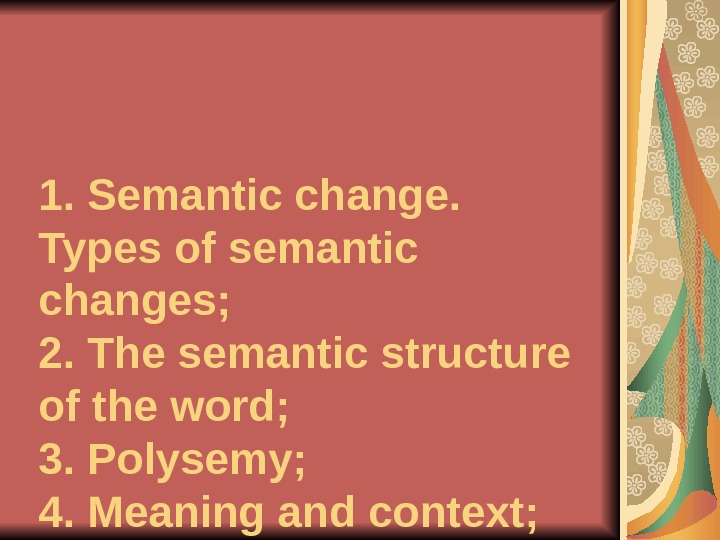
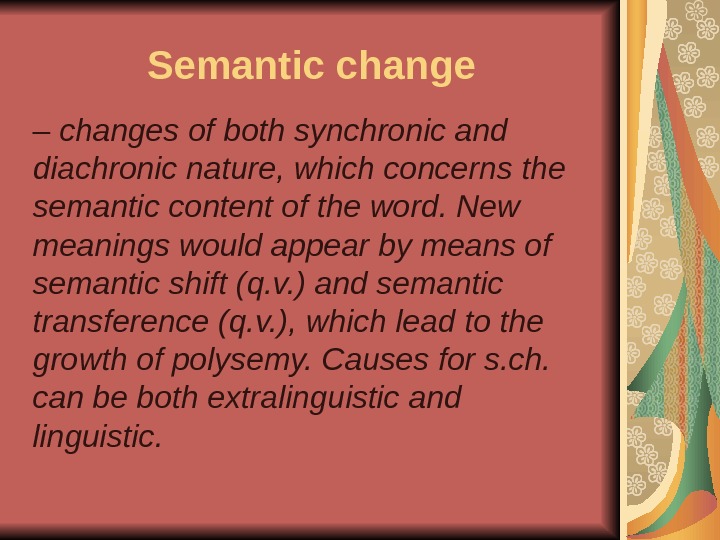
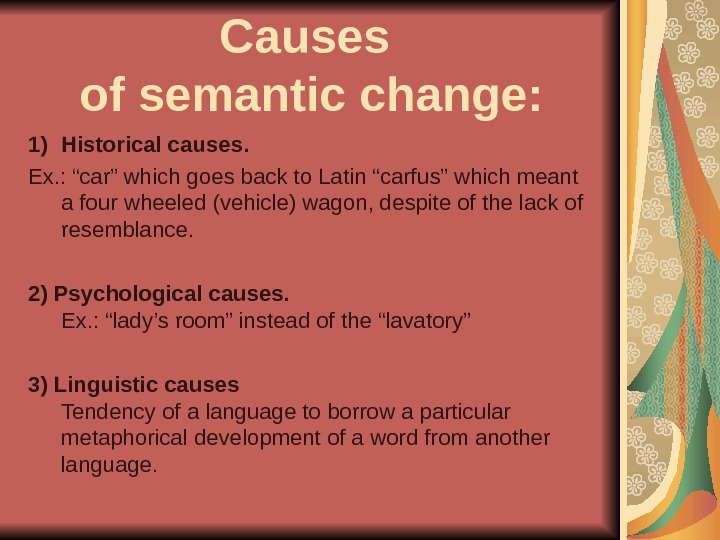
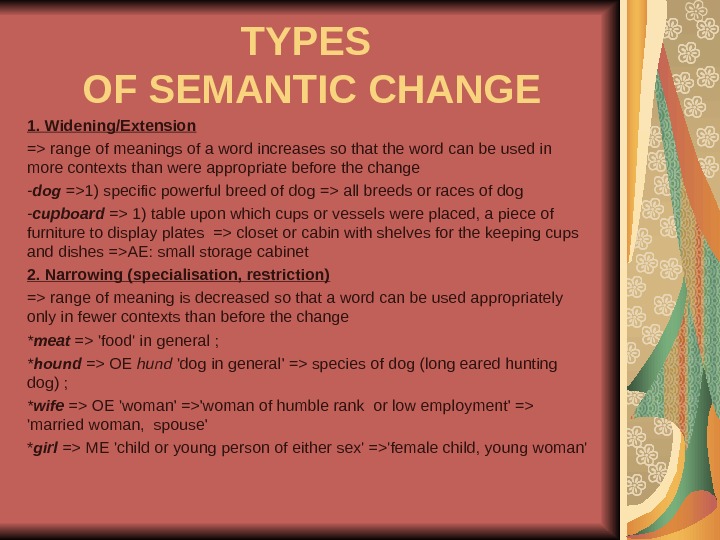
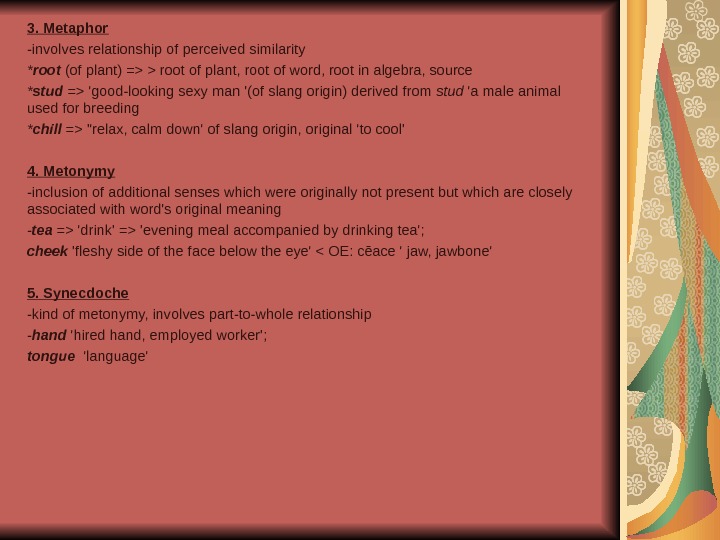

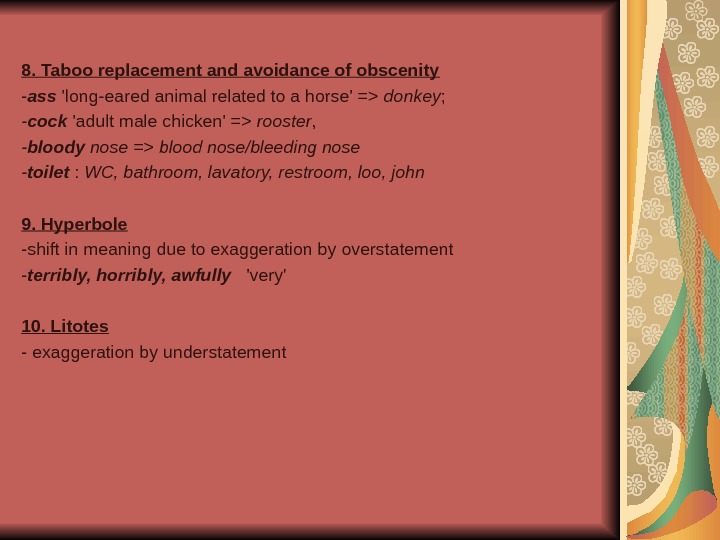
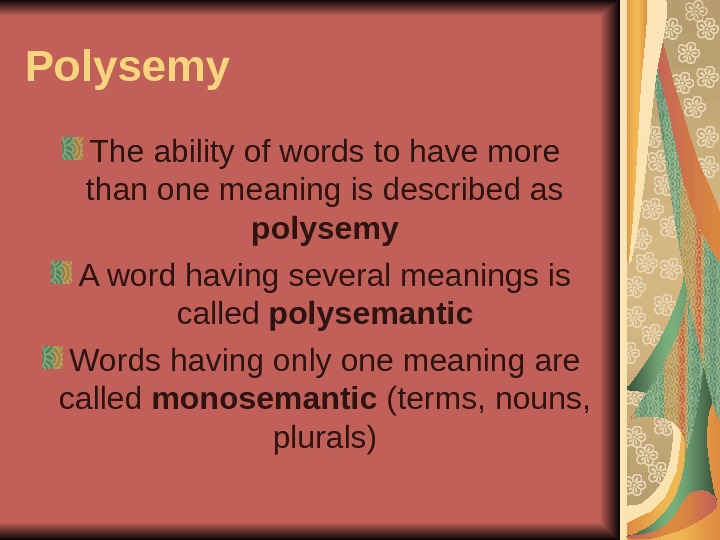
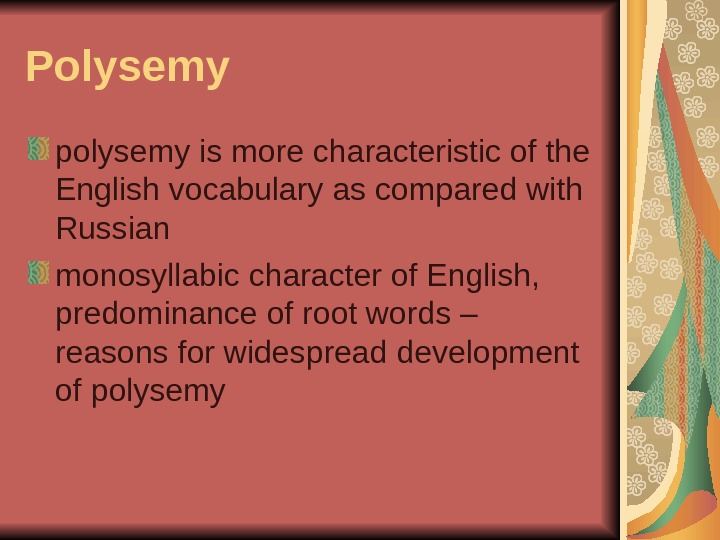
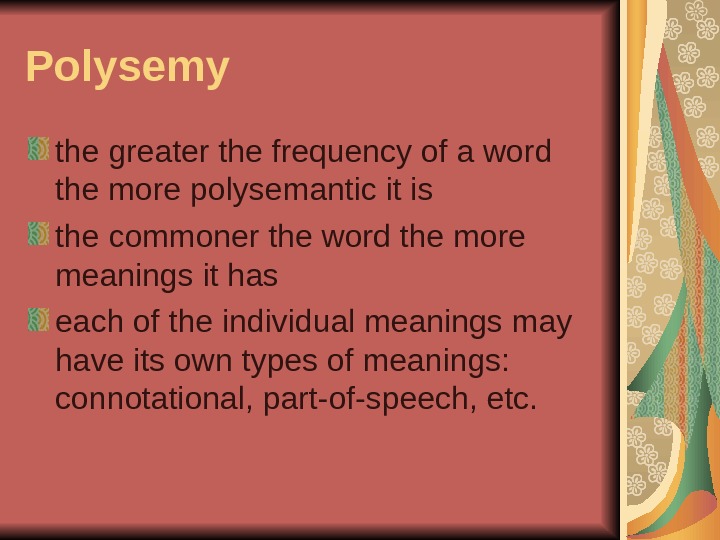
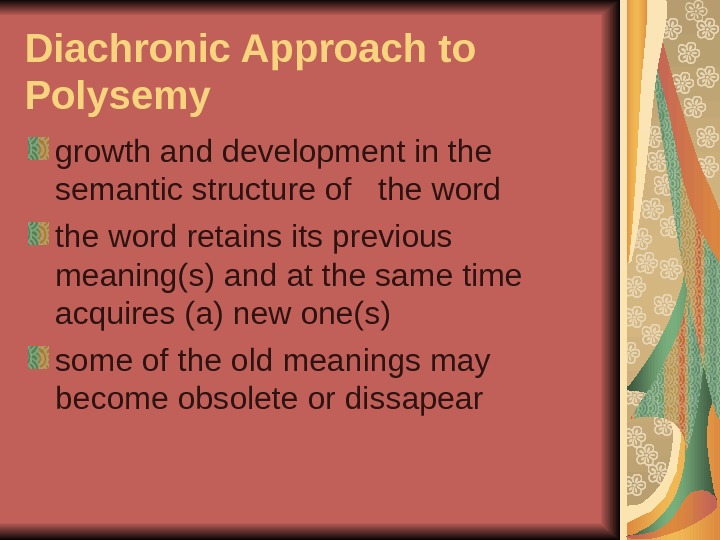
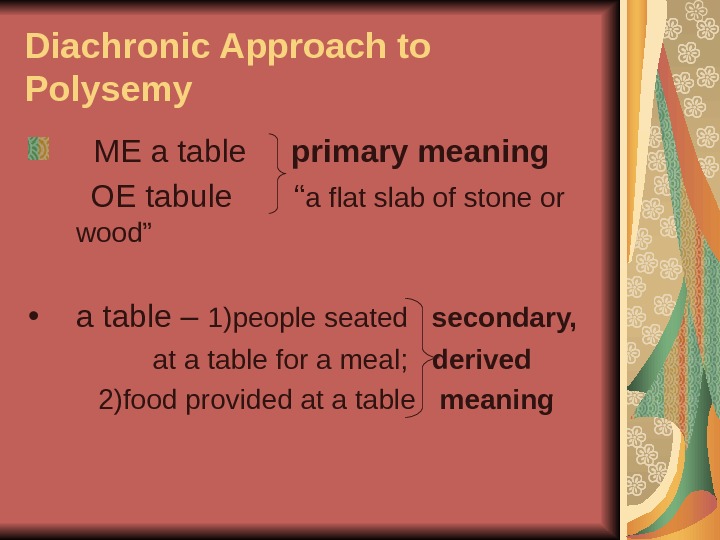

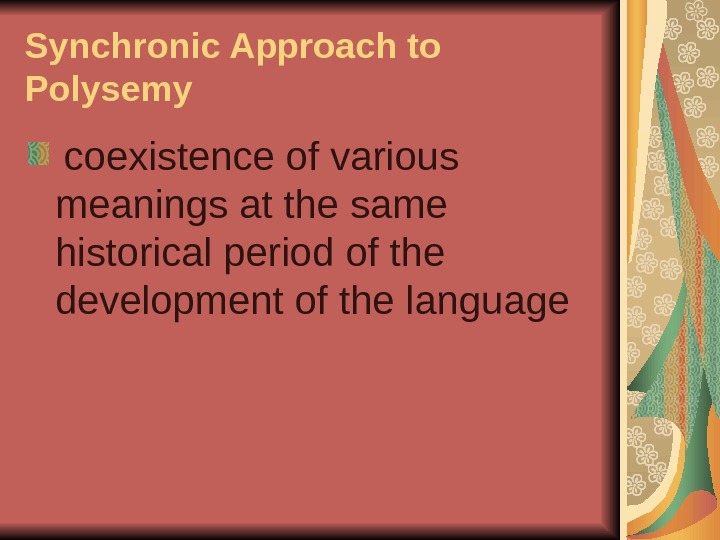
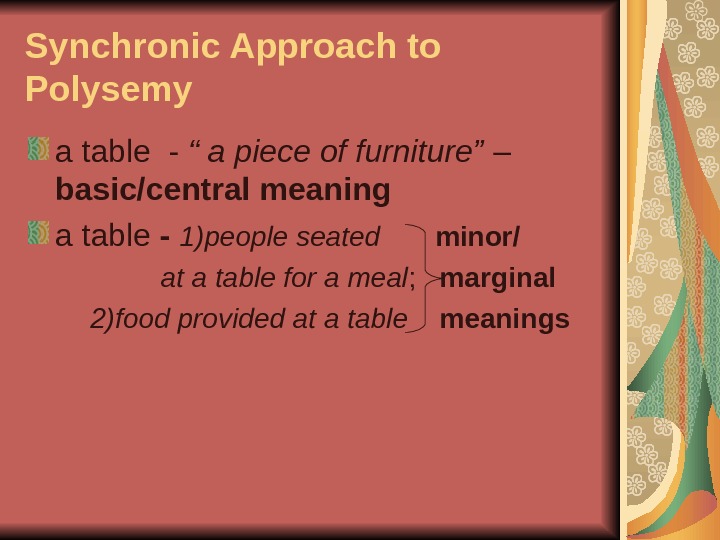
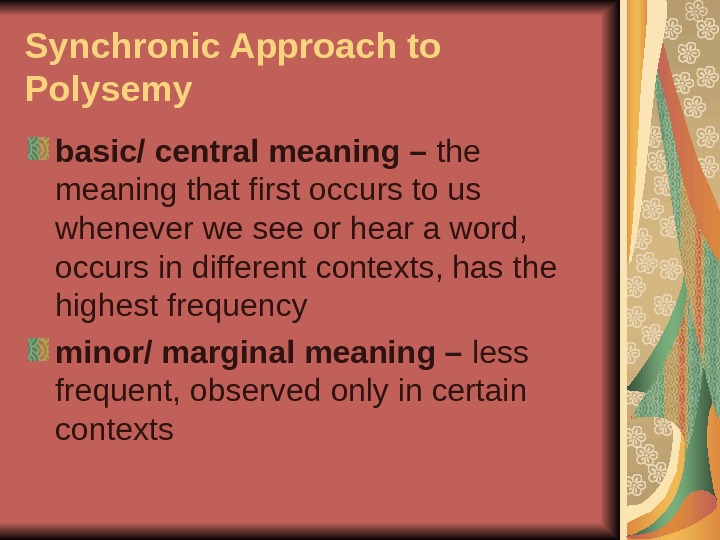
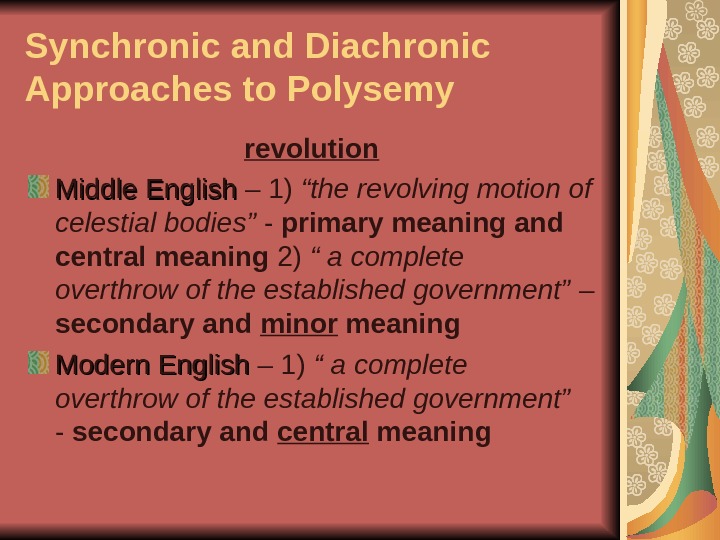
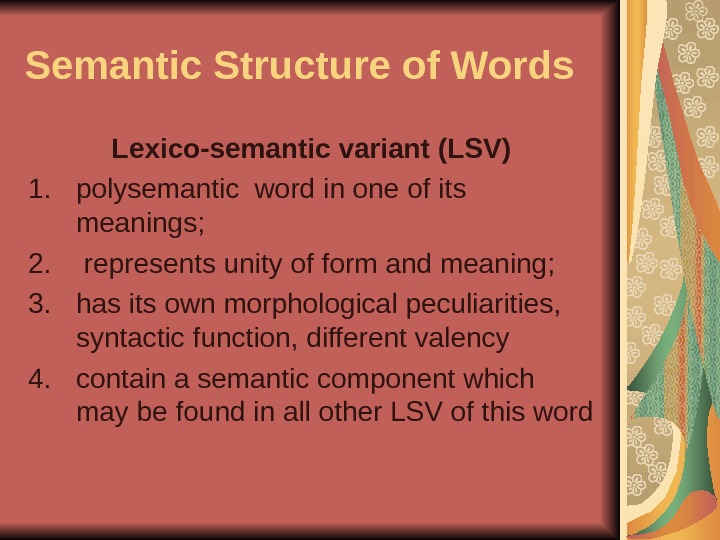

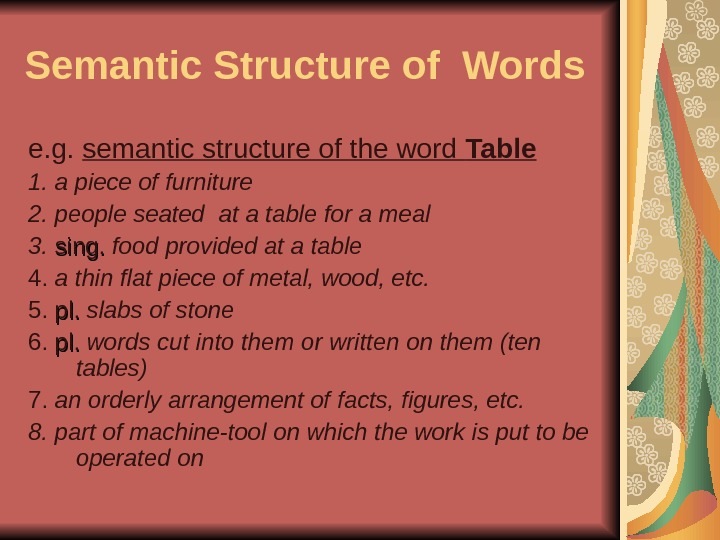
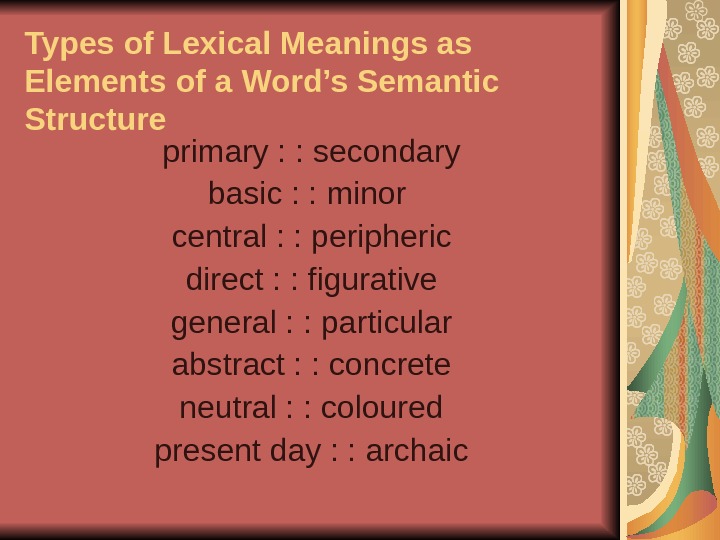
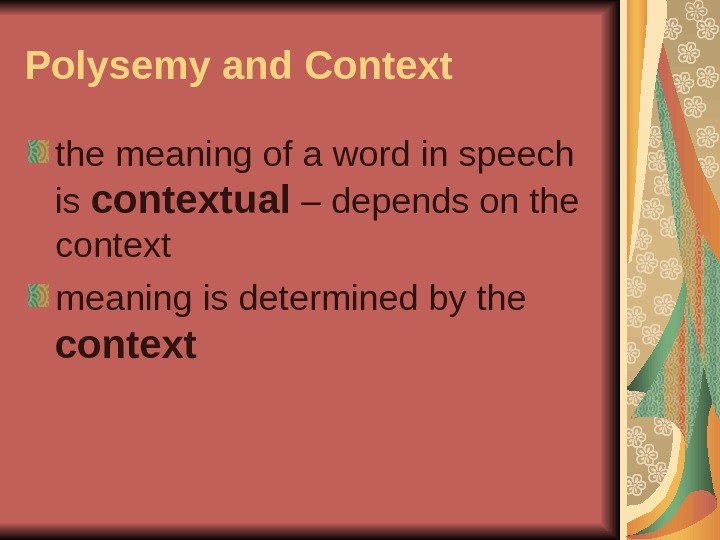
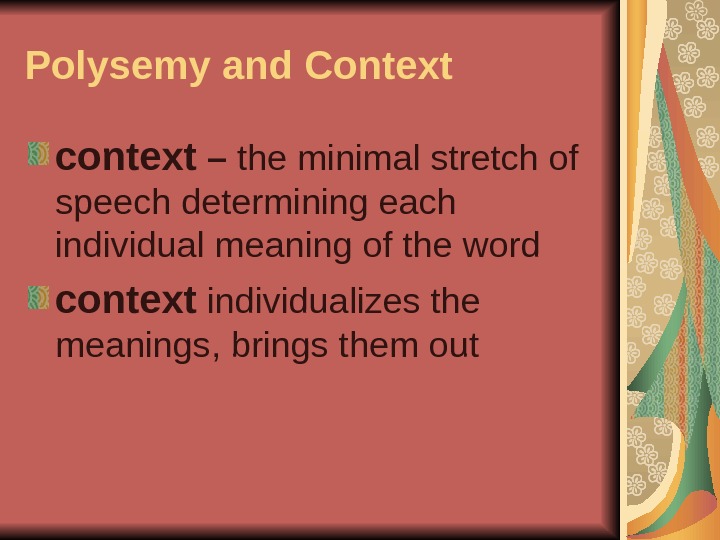
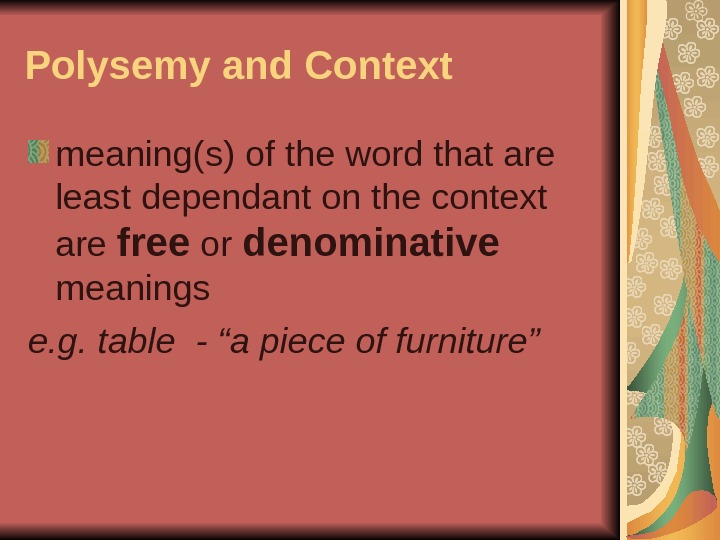
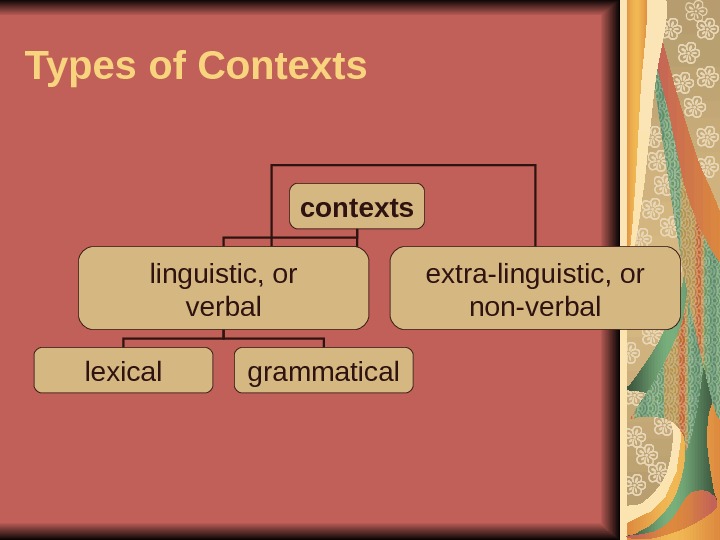
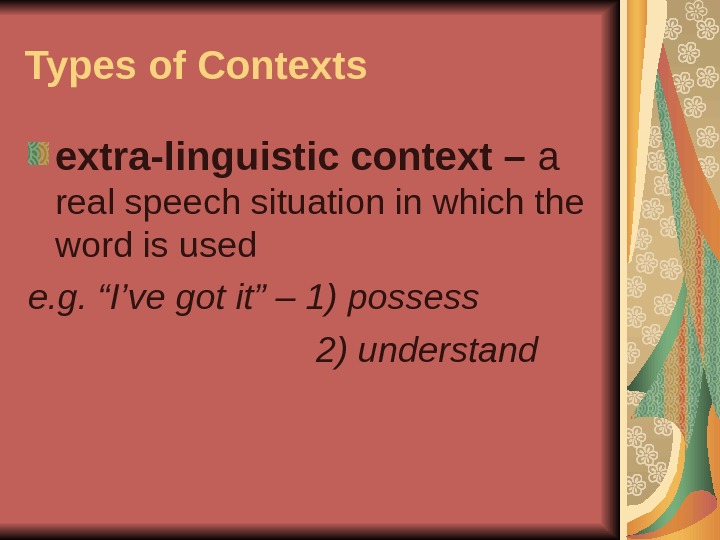
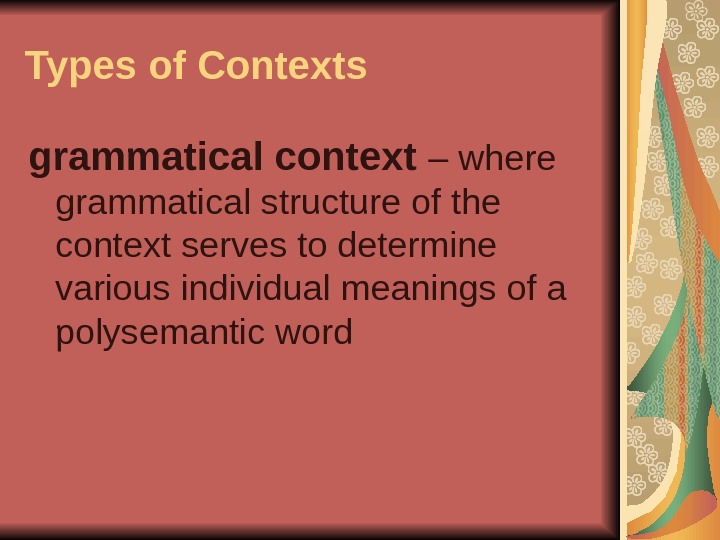

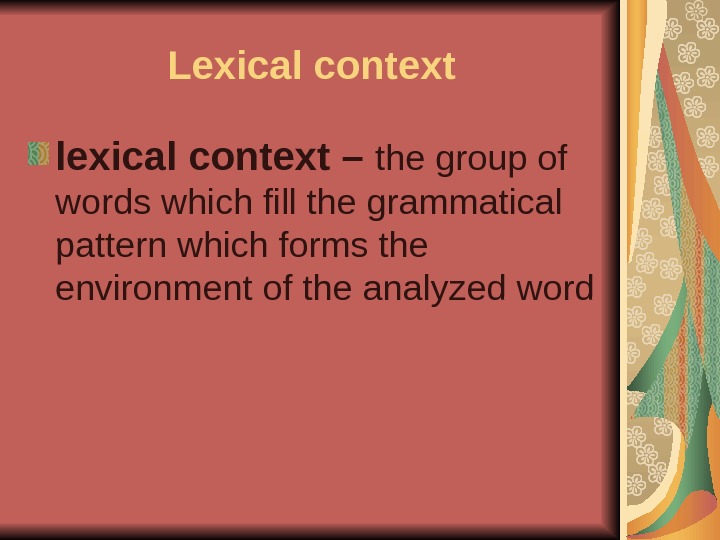
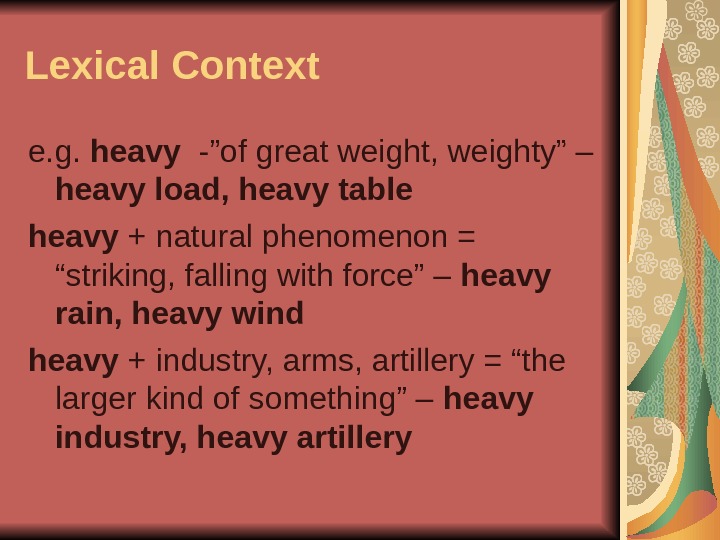
semantic_structure_of_the_word_and_polysemy.ppt
- Размер: 288.5 Кб
- Количество слайдов: 30
Описание презентации 1. Semantic change. Types of semantic changes; по слайдам
 1. Semantic change. Types of semantic changes; 2. The semantic structure of the word; 3. Polysemy; 4. Meaning and context;
1. Semantic change. Types of semantic changes; 2. The semantic structure of the word; 3. Polysemy; 4. Meaning and context;
 Semantic change – changesofbothsynchronicand diachronicnature, whichconcernsthe semanticcontentoftheword. New meaningswouldappearbymeansof semanticshift(q. v. )andsemantic transference(q. v. ), whichleadtothe growthofpolysemy. Causesfors. ch. canbebothextralinguisticand linguistic.
Semantic change – changesofbothsynchronicand diachronicnature, whichconcernsthe semanticcontentoftheword. New meaningswouldappearbymeansof semanticshift(q. v. )andsemantic transference(q. v. ), whichleadtothe growthofpolysemy. Causesfors. ch. canbebothextralinguisticand linguistic.
 Causes of semantic change: 1) Historical causes. Ex. : “car” which goes back to Latin “carfus” which meant a four wheeled (vehicle) wagon, despite of the lack of resemblance. 2) Psychological causes. Ex. : “lady’s room” instead of the “lavatory” 3) Linguistic causes Tendency of a language to borrow a particular metaphorical development of a word from another language.
Causes of semantic change: 1) Historical causes. Ex. : “car” which goes back to Latin “carfus” which meant a four wheeled (vehicle) wagon, despite of the lack of resemblance. 2) Psychological causes. Ex. : “lady’s room” instead of the “lavatory” 3) Linguistic causes Tendency of a language to borrow a particular metaphorical development of a word from another language.
 TYPES OF SEMANTIC CHANGE 1. Widening/Extension => range of meanings of a word increases so that the word can be used in more contexts than were appropriate before the change — dog => 1) specific powerful breed of dog => all breeds or races of dog — cupboard => 1) table upon which cups or vessels were placed, a piece of furniture to display plates => closet or cabin with shelves for the keeping cups and dishes =>AE: small storage cabinet 2. Narrowing (specialisation, restriction) => range of meaning is decreased so that a word can be used appropriately only in fewer contexts than before the change * meat => ‘food’ in general ; * hound => OE hund ‘dog in general’ => species of dog (long eared hunting dog) ; * wife => OE ‘woman’ =>’woman of humble rank or low employment’ => ‘married woman, spouse’ * girl => ME ‘child or young person of either sex’ =>’female child, young woman’
TYPES OF SEMANTIC CHANGE 1. Widening/Extension => range of meanings of a word increases so that the word can be used in more contexts than were appropriate before the change — dog => 1) specific powerful breed of dog => all breeds or races of dog — cupboard => 1) table upon which cups or vessels were placed, a piece of furniture to display plates => closet or cabin with shelves for the keeping cups and dishes =>AE: small storage cabinet 2. Narrowing (specialisation, restriction) => range of meaning is decreased so that a word can be used appropriately only in fewer contexts than before the change * meat => ‘food’ in general ; * hound => OE hund ‘dog in general’ => species of dog (long eared hunting dog) ; * wife => OE ‘woman’ =>’woman of humble rank or low employment’ => ‘married woman, spouse’ * girl => ME ‘child or young person of either sex’ =>’female child, young woman’
 3. Metaphor -involves relationship of perceived similarity * root (of plant) => > root of plant, root of word, root in algebra, source * stud => ‘good-looking sexy man ‘(of slang origin) derived from stud ‘a male animal used for breeding * chill => «relax, calm down’ of slang origin, original ‘to cool’ 4. Metonymy -inclusion of additional senses which were originally not present but which are closely associated with word’s original meaning — tea => ‘drink’ => ‘evening meal accompanied by drinking tea’; cheek ‘fleshy side of the face below the eye’ < OE: cēace ' jaw, jawbone' 5. Synecdoche -kind of metonymy, involves part-to-whole relationship — hand 'hired hand, employed worker'; tongue 'language'
3. Metaphor -involves relationship of perceived similarity * root (of plant) => > root of plant, root of word, root in algebra, source * stud => ‘good-looking sexy man ‘(of slang origin) derived from stud ‘a male animal used for breeding * chill => «relax, calm down’ of slang origin, original ‘to cool’ 4. Metonymy -inclusion of additional senses which were originally not present but which are closely associated with word’s original meaning — tea => ‘drink’ => ‘evening meal accompanied by drinking tea’; cheek ‘fleshy side of the face below the eye’ < OE: cēace ' jaw, jawbone' 5. Synecdoche -kind of metonymy, involves part-to-whole relationship — hand 'hired hand, employed worker'; tongue 'language'
 6. Degeneration / Pejoration -sense of a word takes on a less positive, more negative evaluation in the minds of the users — knave ‘a rogue’ ‘servant’ ; — spinster ‘unmarried woman’ < 'one who spins' ; — silly 'foolish, stupid' < ME sely 'happy, innocent' < OE sælig ''blessed, blissful' — disease 'illness' < 'discomfort' (cf. dis+ease ) 7. Elevation /Amelioration -shifts in the sense of a word in the direction towards a more positive value in the minds of the users — pretty < OE: prættig 'crafty, sly' — knight 'mounted warrior serving a king' 'lesser nobility' ‘servant’ > ‘military servant’; dude ‘guy, person’ < in 1883 a word of ridicule for 'man who affects an exaggerated fastidiousness in dress, speech and deportment', a dandy'
6. Degeneration / Pejoration -sense of a word takes on a less positive, more negative evaluation in the minds of the users — knave ‘a rogue’ ‘servant’ ; — spinster ‘unmarried woman’ < 'one who spins' ; — silly 'foolish, stupid' < ME sely 'happy, innocent' < OE sælig ''blessed, blissful' — disease 'illness' < 'discomfort' (cf. dis+ease ) 7. Elevation /Amelioration -shifts in the sense of a word in the direction towards a more positive value in the minds of the users — pretty < OE: prættig 'crafty, sly' — knight 'mounted warrior serving a king' 'lesser nobility' ‘servant’ > ‘military servant’; dude ‘guy, person’ < in 1883 a word of ridicule for 'man who affects an exaggerated fastidiousness in dress, speech and deportment', a dandy'
 8. Taboo replacement and avoidance of obscenity — ass ‘long-eared animal related to a horse’ => donkey ; — cock ‘adult male chicken’ => rooster , — bloody nose => bloodnose/bleedingnose — toilet : WC, bathroom, lavatory, restroom, loo, john 9. Hyperbole -shift in meaning due to exaggeration by overstatement — terribly, horribly, awfully ‘very’ 10. Litotes — exaggeration by understatement
8. Taboo replacement and avoidance of obscenity — ass ‘long-eared animal related to a horse’ => donkey ; — cock ‘adult male chicken’ => rooster , — bloody nose => bloodnose/bleedingnose — toilet : WC, bathroom, lavatory, restroom, loo, john 9. Hyperbole -shift in meaning due to exaggeration by overstatement — terribly, horribly, awfully ‘very’ 10. Litotes — exaggeration by understatement
 Polysemy The ability of words to have more than one meaning is described as polysemy A word having several meanings is called polysemantic Words having only one meaning are called monosemantic (terms, nouns, plurals)
Polysemy The ability of words to have more than one meaning is described as polysemy A word having several meanings is called polysemantic Words having only one meaning are called monosemantic (terms, nouns, plurals)
 Polysemy polysemy is more characteristic of the English vocabulary as compared with Russian monosyllabic character of English, predominance of root words – reasons for widespread development of polysemy
Polysemy polysemy is more characteristic of the English vocabulary as compared with Russian monosyllabic character of English, predominance of root words – reasons for widespread development of polysemy
 Polysemy the greater the frequency of a word the more polysemantic it is the commoner the word the more meanings it has each of the individual meanings may have its own types of meanings: connotational, part-of-speech, etc.
Polysemy the greater the frequency of a word the more polysemantic it is the commoner the word the more meanings it has each of the individual meanings may have its own types of meanings: connotational, part-of-speech, etc.
 Diachronic Approach to Polysemy growth and development in the semantic structure of the word retains its previous meaning(s) and at the same time acquires (a) new one(s) some of the old meanings may become obsolete or dissapear
Diachronic Approach to Polysemy growth and development in the semantic structure of the word retains its previous meaning(s) and at the same time acquires (a) new one(s) some of the old meanings may become obsolete or dissapear
 Diachronic Approach to Polysemy ME a table primary meaning OE tabule “ a flat slab of stone or wood” • a table – 1)people seated secondary, at a table for a meal; derived 2)food provided at a table meaning
Diachronic Approach to Polysemy ME a table primary meaning OE tabule “ a flat slab of stone or wood” • a table – 1)people seated secondary, at a table for a meal; derived 2)food provided at a table meaning
 Diachronic Approach to Polysemy primary meaning – the first meaning with which the word appeared in the language secondary meaning – could appear only after the primary meaning derived meaning – could not have appeared before primary meaning was in existence and is dependent on it
Diachronic Approach to Polysemy primary meaning – the first meaning with which the word appeared in the language secondary meaning – could appear only after the primary meaning derived meaning – could not have appeared before primary meaning was in existence and is dependent on it
 Synchronic Approach to Polysemy coexistence of various meanings at the same historical period of the development of the language
Synchronic Approach to Polysemy coexistence of various meanings at the same historical period of the development of the language
 Synchronic Approach to Polysemy a table — “apieceoffurniture” – basic/central meaning a table — 1)peopleseated minor/ atatableforameal ; marginal 2)foodprovidedatatable meanings
Synchronic Approach to Polysemy a table — “apieceoffurniture” – basic/central meaning a table — 1)peopleseated minor/ atatableforameal ; marginal 2)foodprovidedatatable meanings
 Synchronic Approach to Polysemy basic/ central meaning – the meaning that first occurs to us whenever we see or hear a word, occurs in different contexts, has the highest frequency minor/ marginal meaning – less frequent, observed only in certain contexts
Synchronic Approach to Polysemy basic/ central meaning – the meaning that first occurs to us whenever we see or hear a word, occurs in different contexts, has the highest frequency minor/ marginal meaning – less frequent, observed only in certain contexts
 Synchronic and Diachronic Approaches to Polysemy revolution Middle English – 1) “therevolvingmotionof celestialbodies” — primary meaning and central meaning 2) “acomplete overthrowoftheestablishedgovernment” – secondary and minor meaning Modern English – 1) “acomplete overthrowoftheestablishedgovernment” — secondary and central meaning
Synchronic and Diachronic Approaches to Polysemy revolution Middle English – 1) “therevolvingmotionof celestialbodies” — primary meaning and central meaning 2) “acomplete overthrowoftheestablishedgovernment” – secondary and minor meaning Modern English – 1) “acomplete overthrowoftheestablishedgovernment” — secondary and central meaning
 Semantic Structure of Words Lexico-semantic variant (LSV) 1. polysemantic word in one of its meanings; 2. represents unity of form and meaning; 3. has its own morphological peculiarities, syntactic function, different valency 4. contain a semantic component which may be found in all other LSV of this word
Semantic Structure of Words Lexico-semantic variant (LSV) 1. polysemantic word in one of its meanings; 2. represents unity of form and meaning; 3. has its own morphological peculiarities, syntactic function, different valency 4. contain a semantic component which may be found in all other LSV of this word
 Semantic Structure of Words semantic structure of a word – a structured set of interrelated lexico-semantic variants semantic structure of a word – combination of various meanings
Semantic Structure of Words semantic structure of a word – a structured set of interrelated lexico-semantic variants semantic structure of a word – combination of various meanings
 Semantic Structure of Words e. g. semantic structure of the word Table 1. apieceoffurniture 2. peopleseated atatableforameal 3. sing. foodprovidedatatable 4. athinflatpieceofmetal, wood, etc. 5. pl. slabsofstone 6. pl. wordscutintothemorwrittenonthem(ten tables) 7. anorderlyarrangementoffacts, figures, etc. 8. partofmachine-toolonwhichtheworkisputtobe operatedon
Semantic Structure of Words e. g. semantic structure of the word Table 1. apieceoffurniture 2. peopleseated atatableforameal 3. sing. foodprovidedatatable 4. athinflatpieceofmetal, wood, etc. 5. pl. slabsofstone 6. pl. wordscutintothemorwrittenonthem(ten tables) 7. anorderlyarrangementoffacts, figures, etc. 8. partofmachine-toolonwhichtheworkisputtobe operatedon
 Types of Lexical Meanings as Elements of a Word’s Semantic Structure primary : : secondary basic : : minor central : : peripheric direct : : figurative general : : particular abstract : : concrete neutral : : coloured present day : : archaic
Types of Lexical Meanings as Elements of a Word’s Semantic Structure primary : : secondary basic : : minor central : : peripheric direct : : figurative general : : particular abstract : : concrete neutral : : coloured present day : : archaic
 Polysemy and Context the meaning of a word in speech is contextual – depends on the context meaning is determined by the context
Polysemy and Context the meaning of a word in speech is contextual – depends on the context meaning is determined by the context
 Polysemy and Context context – the minimal stretch of speech determining each individual meaning of the word context individualizes the meanings, brings them out
Polysemy and Context context – the minimal stretch of speech determining each individual meaning of the word context individualizes the meanings, brings them out
 Polysemy and Context meaning(s) of the word that are least dependant on the context are free or denominative meanings e. g. table-“apieceoffurniture”
Polysemy and Context meaning(s) of the word that are least dependant on the context are free or denominative meanings e. g. table-“apieceoffurniture”
 Types of Contexts contexts linguistic, or verbal extra-linguistic, or non-verbal lexical grammatical
Types of Contexts contexts linguistic, or verbal extra-linguistic, or non-verbal lexical grammatical
 Types of Contexts extra-linguistic context – a real speech situation in which the word is used e. g. “I’vegotit”– 1)possess 2)understand
Types of Contexts extra-linguistic context – a real speech situation in which the word is used e. g. “I’vegotit”– 1)possess 2)understand
 Types of Contexts grammatical context – where grammatical structure of the context serves to determine various individual meanings of a polysemantic word
Types of Contexts grammatical context – where grammatical structure of the context serves to determine various individual meanings of a polysemantic word
 Grammatical Context e. g. tomake – 1)“toforce, to induce”– makesomebodydo something –“make+smbd+ bareinfinitive” 2)“tobecome, toturnouttobe”– makeagoodwife –make+ adjective+noun
Grammatical Context e. g. tomake – 1)“toforce, to induce”– makesomebodydo something –“make+smbd+ bareinfinitive” 2)“tobecome, toturnouttobe”– makeagoodwife –make+ adjective+noun
 Lexical context lexical context – the group of words which fill the grammatical pattern which forms the environment of the analyzed word
Lexical context lexical context – the group of words which fill the grammatical pattern which forms the environment of the analyzed word
 Lexical Context e. g. heavy -”of great weight, weighty” – heavy load, heavy table heavy + natural phenomenon = “striking, falling with force” – heavy rain, heavy wind heavy + industry, arms, artillery = “the larger kind of something” – heavy industry, heavy artillery
Lexical Context e. g. heavy -”of great weight, weighty” – heavy load, heavy table heavy + natural phenomenon = “striking, falling with force” – heavy rain, heavy wind heavy + industry, arms, artillery = “the larger kind of something” – heavy industry, heavy artillery

